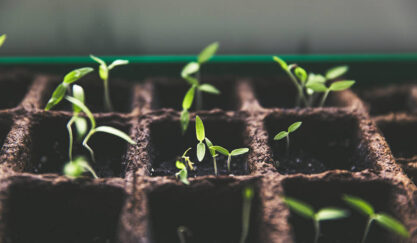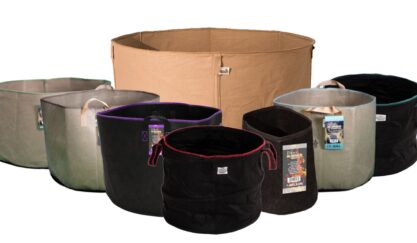Air Pruning And Container Gardening Guide
Have you heard of air root pruning? It is a natural growing technique that allows dry air to reach root tips which stops roots from extending beyond their container.
But why would we want to slow down root growth?
PLANTING CONTAINERS
Moving past plastic grows in container gardening
When a root stops growing it naturally encourages new roots to sprout into a branched structure. A branched root structure covers more area and is more effective at water and nutrient uptake, which in turn leads to a stronger, healthier plant and better yields. But it all comes down to your container choice.
Container gardening has been a hot topic lately and that’s no surprise given all the benefits it provides private and commercial growers alike. It offers urban gardeners the opportunity to grow in small spaces and in areas of poor soil composition and it gives commercial gardeners higher quality products and more freedom in distribution. But there are also disadvantages to container gardening. Currently the most popular containers are plastic pots.
There are several drawbacks to using plastic pots for growing:
- Plastic pots have poor water drainage which can lead to “wet feet” or plants whose roots are waterlogged. When plant roots are waterlogged they are unable to get oxygen from the soil and essentially drown. Wet feet can also lead to viruses, fungi and bacteria.
- They encourage roots that have reached the edge of the container to begin winding around one another until the plant is “root bound”. The roots will continue winding around the container and themselves until there is no room. A root bound plant will be weaker, grow slower and is easily damaged during transplanting.
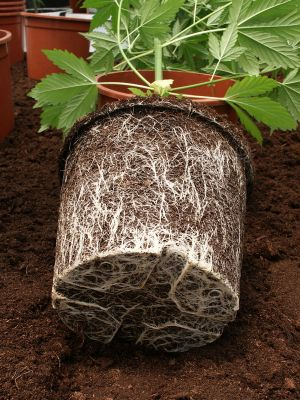
“So what is a grower to do?”
This is where the folks at Spring Pot come in. We offer uniquely designed root pruning pots that allow air to penetrate the walls and reach roots, which is essential for air root pruning. It keeps the roots from binding around one another and the container and also allows proper water drainage so you can avoid wet feet.
What have you heard about the air root pruning technique? Here are some things you may not have known about this unique growing method.
FACTS
about air pruning pots…
Air root pruning prevents roots from becoming entangled and root bound
You’ve probably seen it many times before during the transplanting process. You remove the plant from the pot and out comes a hard knot of twisted roots clinging to the bottom. Since plastic pots are non-porous, very little air can get to the roots of the plants. So when the roots hit the pot walls they begin to spiral around the inside girdling one another and often overflowing through the holes in the bottom. This can cause damage to the root system and can be debilitating to the plant, especially when you are transplanting and have to loosen the root system before repotting.
When you use a pot like the Fabric Burner Pots by Spring Pot, air is able to penetrate the fabric and reach the roots. Essentially, this dry air lets the plant know that the root system has reached the limits of its container. Instead of spiraling around the pot the root will stop growing longer and the plant will produce more roots to branch off in another direction. This also keeps the roots from reaching downward through the drainage holes in the bottom of the pot. No more ripping and tearing during transplanting
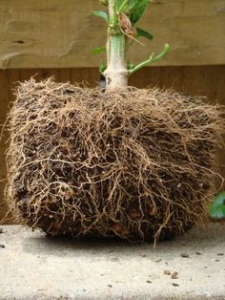
It happens naturally in the right environment
Air root pruning is simple and natural. It comes down to making sure the plants exist in a healthy environment that allows their roots to grow freely and be properly aerated. There is no need for expensive tools, synthetic products or manual trimming of the roots like some growing methods require.
All you need is three things:
- The right fabric container with breathable sides to allow a good amount of air flow to reach the root tips
- An environment that is not too humid
- Proper water drainage so roots are not waterlogged in the soil
You can use the same size container for longer
When you have a root system that has reached the edges of the pot and is strangling itself the only option is to move up to a bigger pot and hope you don’t damage the roots in the process. When plants are kept in pots with poor air circulation the roots naturally reach as far as they can turning and burrowing through the drainage holes to seek out nutrients, water and oxygen. The result is long, spindly roots that are not only less efficient at absorbing nutrients but less effective at using the space in their container.

Air root pruning results in a denser root system that takes up more surface area within the pot and stops before it reaches the containers limits. It is a branched system of shorter, healthier roots that are more efficient at collecting water and nutrients. It takes a longer time to build a denser root system than to grow a few long and spindly roots and it is this slower root growth that allows you to keep your plants in their pots longer before transplanting.
Air root pruning offers better growth with less environmental concerns
Air root pruning can be a very effective way of improving plant growth without introducing chemical fertilizers. But why worry about fertilizer usage? One of the main concerns when using synthetic fertilizers to boost plant growth is the threat of these chemicals leaching into the soil contaminating the groundwater. Even the use of many organic and naturally derived and fertilizers can have ill effects on the environment as they are high in nitrogen. If too much nitrogen is carried from the soil to local water sources it can have devastating effects on plants and wildlife in the area. On the other hand, the air root pruning technique works by encouraging the plant’s natural root growth without having to supplement with unnecessary amounts of chemical fertilizers.
Also, plastic pots that are commonly used for other growing techniques degrade more quickly and break much easier than fabric pots used with air root pruning. Spring Pot’s fabric pots are very durable and will last through multiple seasons of use. They can also be recycled to avoid adding more garbage to the landfill.
MYTHS
But I’ve heard that…
Air root pruning techniques are more expensive
While there is an initial investment in getting the right containers for the job, the technique can actually save you money in the long run. Instead of investing in natural or synthetic fertilizers to help boost the growth of your plants, the denser root system that results from air root pruning does the job for you and creates healthier and higher yielding top growth.
Purchasing plastic containers every growing season weighs heavy on the wallet, while Spring Pot’s containers are both cost effective and last for years. While plastic pots tend to wear out and break, fabric pots are durable and last for multiple seasons.
Air root pruning requires no additional tools or fertilizers and with practical, cost effective containers and higher yields you can’t go wrong.
Fabric containers used for air root pruning are cumbersome and difficult to maneuver
Some brands of fabric pot can be more of a hassle than they are worth. Since their sides lack rigidity, it can take several people to fill them and it can be difficult to move from place to place, which leads to troublesome transplanting.
Spring Pot has taken care of these issues by engineering the Classic Spring Pot that holds its shape using an internal spring allowing them to stand on their own. This makes it easy for a single person to fill them without struggling to keep it upright at the same time.
And they are even easier to move around than plastic pots. The Classic Spring Pot and the Fabric Burner Pot both come with convenient handles making them less bulky and cumbersome to move.

It damages plant roots
Other root pruning techniques that require digging the plant up and cutting the roots with tools can not only do damage to roots but can also introduce viruses, bacteria and fungi, all of which can do permanent damage to a plant.
Air root pruning is a natural, hands-off method that does not stress the plant.
Transplanting is also safer and easier as plants do not become root bound in their pots and therefore roots have less chance of being damaged in the process.
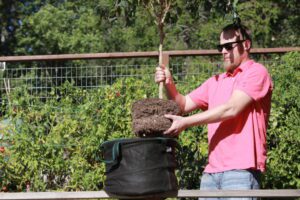
Bigger root systems mean bigger pots
Air pruned root systems form denser, branched structures that expand over a greater surface area within the pot without curling their way around the sides and becoming entangled. While they are a bulkier root system they are not as long and reaching as the roots of other container grown plants.
Any plant that is grown in a container will need to be consistently transplanted to a larger size pot to maintain healthy growth. However, plants that are air pruned do not need to be transplanted as often as there is little risk of them becoming root bound like a plant whose roots do not have access to adequate airflow.
Air root pruning requires more maintenance
There are a lot of pruning techniques out there that are time consuming and expensive for both the private and commercial grower to maintain. Thankfully, air root pruning is not one of them.
Container choice is the most important aspect of this root pruning method as good airflow to the roots is essential. It is also important to use a growing medium that does not inhibit root growth and to keep the medium moist but not waterlogged. And just like that you will have healthier, stronger and higher producing top growth.
Fabric pots require more watering
Fabric pots like the Classic Spring Pot do an excellent job of draining excess water. Plastic pots are known for poor drainage which can result in root rot. Additionally, when plant roots sit in saturated soil they are more likely to contract a disease or fungus. You will find that with the Spring Pot fabric pots you can use a more nutrient rich mixture of soil and compost that holds water better than lighter materials like peat moss and vermiculite as the water will drain easily from the pots.
It will stunt the growth of the plant
Bonsai always comes to mind when people thinking of root pruning. Bonsai root pruning, in the simplest terms, involves removing a plant from the pot, trimming off a few choice sections of the roots and repotting it. Bonsai growers will repeat this process as often as several times a year in some cases. The purpose of this root trimming is to keep the plants very small without pruning their top growth. So wouldn’t the same hold true for plants using the air root pruning method?
A few things are different about the air root pruning method:
- plants are not removed from the soil, which can cause stress and reduce growth
- plant roots are not trimmed or cut using tools
- plants are only repotted or transplanted when growth rates slow and the plants require a larger container
Instead of being cut back, the plant’s hormones signal the root to stop growing in a certain direction and instead send out new root growth in another direction, keeping the plant growing vigorously and absorbing nutrients from the soil. So while plants may need to be transplanted less often their top growth will not suffer any consequences.
Air root pruning is a simple, efficient and cost effective way to get your plants growing stronger and producing more just by giving them a healthier environment. Check out the Spring Pot products to get your plants started on the right track.


